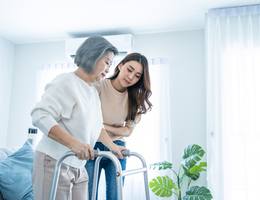
Every year, about 795,000 people in the United States have a stroke, according to the American Stroke Association (ASA). Depending on what part of the brain is affected and how severely, every stroke survivor faces unique challenges during recovery.
Some people have few long-term effects from stroke, while others have profound adjustments to make in how they live every day. No matter where a person lies on this spectrum, a rehabilitation program can help make the most of life after stroke.
How rehab can help
The potential effects of stroke fall into five categories, according to the National Institute of Neurological Disorders and Stroke:
- Problems moving or controlling movement. This may include weakness or paralysis on one side of the body, poor balance and trouble swallowing.
- Sensory disturbances, such as pain, numbness, or sensations of tingling or prickling in affected limbs, and poor control of the bladder or bowels. Loss of continence or bowel control usually is linked to a combination of movement and sensory deficits.
- Problems communicating with or understanding other people.
- Difficulties with thinking or memory, such as forgetfulness and trouble with problem solving.
- Emotional disturbances, such as fear, anxiety, depression, anger or grief.
Some of these effects may lessen over time as the brain heals. Others can be improved with specific, targeted rehabilitation therapies. When the long-term effects of stroke can't be changed or lessened, rehabilitation can help people learn new ways to do things, such as bathing and dressing with one arm and hand instead of two, or communicating through signs or writing instead of speech.
Treatments often used for stroke rehabilitation include:
Physical therapy. This therapy focuses on problems with movements and sensation. It helps people regain basic abilities, such as walking, sitting, climbing stairs, lying down and moving from one position to another.
Occupational therapy. The focus of this therapy is on specific daily tasks, such as eating, dressing, bathing, cleaning house, cooking, gardening, reading, writing and driving.
Speech-language therapy. When stroke affects the ability to speak or communicate, this therapy can help a person regain language skills or learn new ways to communicate, such as using signs, boards or computers. It can also help when a stroke has damaged the ability to swallow.
Vocational therapy. This therapy helps people identify their strengths and limitations related to the workplace. Vocational therapists also help people develop résumés, find potential employers, conduct job searches and learn about their legal rights at work.
Psychological therapy. Many stroke survivors and their families can benefit greatly from treatments that help with processing and handling strong emotions related to stroke. These emotions may arise in response to the changes and adjustments that come after a stroke. In some cases, emotional changes result directly from damage to brain tissues.
Rehabilitation can also include nutritional therapy, nursing care, social work, support groups, education and spiritual support from a chaplain.
A doctor helps each person develop a personal rehabilitation plan that addresses his or her unique needs and goals. Rehabilitation starts as soon as possible, often within 24 to 48 hours of the stroke and can continue until well after the person has left the hospital for a rehabilitation center, nursing facility or their home.
Recipe for success
According to the ASA, the overall success of rehabilitation depends on how early it starts, how severely the brain is damaged, the survivor's attitude, the skill of the rehabilitation team, and cooperation from the survivor's family and friends.
Research continues on new treatments and techniques for stroke rehabilitation.
Reviewed 8/18/2025